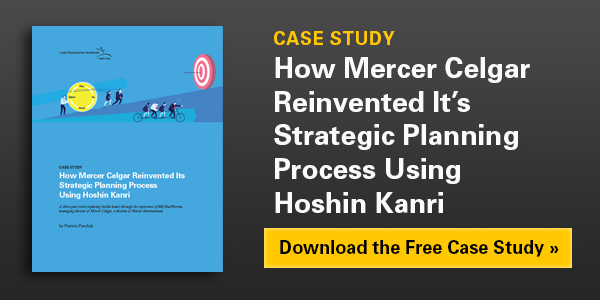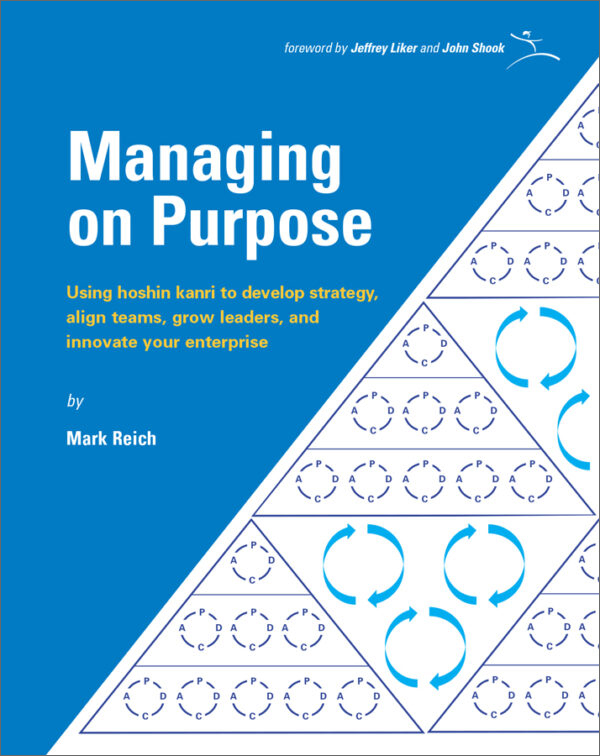As Mercer International’s Celgar Mill leaders complete their first hoshin, they now understand that adopting hoshin kanri changes more than how an organization develops and deploys a strategic plan. They see that it also transforms how an organization’s leaders lead and develop their team members’ capabilities – and, critically, that the hoshin kanri discipline enables them to achieve these goals concurrently while they’re doing the work. For the Mercer Celgar leaders, these additional facets of hoshin conveniently mesh with their belief that a leader’s most important contribution is developing their team members, which requires that the leader become a better teacher and coach.

Read part one, Breaking the Cycle of Ineffective Strategic Planning and Execution.
Read part two, Continually Improving the Strategic Planning and Execution Process.
Now, heading into their second year, they’re doubling down on acting on that belief. The Celgar leaders plan to extend problem-solving coaching throughout the organization, with a focus on at-the-gemba improvements. To do this, they will again tap the Lean Enterprise Institute by having leaders take part in lean leadership coaching. Specifically, the leaders will participate in a new lean leader executive coaching experience developed and led by LEI Senior Lean Coach Mark Reich, which immerses leaders and soon-to-be leaders in learning two vital practices. First, Reich coaches the leaders on how to solve problems using the A3 methodology. Then, he coaches them as they coach their team members to solve problems the A3 way. In both phases, the activities focus on solving an existing business problem at the company.
Critically, the experience challenges leaders to interrogate their current view of effective leadership, the impact of ineffective leadership, and their organization’s leadership practices, enabling leaders to transform their leadership mindset and practices and gain an in-depth understanding of the why and how of lean leadership.
Addressing Ineffective Problem-Solving
Creating a hoshin – a strategic plan — involves a process that engages everyone at every level of an organization through a series of top-down, bottom-up communications that ensures that everyone is aligned on and understands the company objectives and knows their role in helping achieve them. With this two-way communication, those who are closest to the work influence the plan and, as a result, become more invested in executing it.
As they executed the 2021 hoshin, the Celgar Mill team began to understand that day-to-day leadership, specifically problem-solving, could be improved through a similar two-way communication process. Significantly, the leaders realized that they tended to solve problems for their team members — “cascading the solutions to them,” instead of involving them in determining a solution. “What we found through the work is that we don’t go to the gemba to really understand and unravel the problem,” MacPherson says. “We were about deploying a bunch of solutions that we already had in mind.” He notes this practice is disrespectful to the person closest to and doing the work and, as bad, ineffective for various reasons.
First, as they executed the hoshin using A3 thinking and problem-solving, the team “often found the problem that we thought needed to be solved wasn’t the problem at all. It was something completely different,” MacPherson says. This misdiagnosis is an issue itself but also leads to what he calls “problem churn,” where you never truly solve the problem.
When solutions “are cascaded from the top, with just the top of the organization doing the thinking, you never quite get to root cause,” he says. “You might resolve 60% or 70% or 80%, but you’re never able to go ‘off the chart,’ and then spend time gaining organizational efficiencies by freeing yourself up from the waste that goes on from the churn.”
Further, when all the thinking is isolated at the top of the hierarchy, an organization limits its problem-solving capacity, notes MacPherson. The better way, he says, is when leaders go to the worksite with an open mind to ask questions and hear from the person doing the work, which helps properly identify the root cause of and potential solutions to the problem.
We’re learning now, as leaders, you can’t do an A3 – one that’s well done – without spending a lot of time at the bottom of that hierarchy, where the work happens.
And that’s where A3 problem-solving comes in. “We’re learning now, as leaders, you can’t do an A3 – one that’s well done – without spending a lot of time at the bottom of that hierarchy, where the work happens,” he says.
“We’re now diving into A3 as leaders, and it’s transforming us into becoming problem-solv[ing coaches] instead of cascading solutions down the organization,” MacPherson says. But, as important as better problem-solving is, the most significant benefit to the new approach is that it leads to increased team member engagement. So, instead of only the top third thinking, the Celgar Mill can potentially have all 417 team members become effective problem-solvers.
Adopting a New Education and Training Philosophy
Mercer’s Celgar team is now convinced that executing the hoshin using A3 management ultimately is a better way to address the most important leadership challenge: helping others develop their capabilities through more effective leadership.
MacPherson reflects on the difference between how most organizations “train” their workforces compared with A3 problem-solving. In the former, people are “sent away somewhere for a week-long session and come back having likely never practiced or rarely practiced what was learned,” he explains. With A3, people learn and are coached as they address obstacles to achieving their goals, which, in turn, contribute to the business’ progress toward achieving its hoshin objectives.
The value of this online learning with guided coaching is that we’re developing the skills while practicing; it feels almost free in terms of cost. It’s extremely affordable compared to all other forms of training I’ve found.
He notes that LEI workshops he and his team have attended work the same way. “The value of this online learning with guided coaching is that we’re developing the skills while practicing; it feels almost free in terms of cost. It’s extremely affordable compared to all other forms of training I’ve found.”
MacPherson credits this coaching for helping him develop his capability to help others improve theirs. “There’s nothing more validating or gratifying than knowing you’ve actually helped somebody, equipped them with the ability to be more successful and help others to be more successful. It’s a multiplicative effect,” MacPherson says.
“It has us leaders saying this strategic partnership that’s developing between us and LEI is something that we’re looking forward to expanding and growing,” MacPherson declares. “We started with hoshin kanri, and we’re excited about where we can take this once we get through A3 [training], what might be next because we’re getting hungry, becoming better leaders, and helping the organization succeed.”
Learning More

Meet Senior Lean Coach Mark Reich, who stands ready to design an education and coaching program to help you adopt hoshin kanri and A3 problem-solving at your organization. In the tradition of LEI’s custom coaching approach, he’ll create a learning experience that will help you learn as you address a real and meaningful business objective. Schedule time today to talk with a lean coach.
Managing a Lean Enterprise
Learn how to drive performance and inspire innovation using hoshin kanri, daily management, and A3 process.




